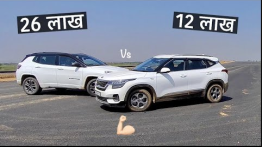So far, the Kia QYI sub-4 metre SUV was confirmed only for a country - India. Now, it has been confirmed for two regions - Asia-Pacific (which includes India) and the Middle East. India will most likely be the first market to get this product, and that will happen in H2 2020.

Kia already has a global SUV smaller than the Seltos - the Stonic. But since it is longer than 4-metres, it isn't feasible for our market. It is sold in many other Asia-Pacific markets and in the Middle East. It will be interesting to see if the company offers the Stonic and QYI both in any international market. China is one market we can already think of where that would be the case.
Kia will most likely unveil a near-production QYI at Auto Expo 2020. It has already started testing the upcoming SUV on the public roads in India as well as South Korea. The company says that it will bring forward a host of modern features with the Carnival and the QYI, including the next-gen e-Call telematics, advanced GPS and navigation systems, remote ignition and real-time traffic monitoring and several comfort-oriented features.
The Kia QYI will be based on the same platform which sits under the Hyundai Venue. This platform, in one or other version, is also used in a variety of B- and C-segment models from both the brands (Kia and Hyundai).
Expect the Indian-spec Kia QYI to be sold with a 120 PS 1.0L turbocharged petrol engine, a 115 PS 1.5L naturally aspirated petrol engine and a 115 PS 1.5L turbocharged diesel engine. All the engines will be mated to a standard 6-speed manual transmission as standard, while an automatic transmission, a 7-speed dual-clutch unit, might be offered only with the 1.0L petrol engine.

Also See: Alleged Kia sub-4 metre SUV (Kia QYI) spied in S. Korea
In India, the Kia QYI will sit higher than the Hyundai Venue in terms of pricing. For the record, the Hyundai Venue currently retails in the range of INR 6.5-11.11 lakh (ex-showroom, Delhi). Models like the Maruti Brezza, Mahindra XUV300, Tata Nexon and the Ford EcoSport will be its direct competitors.




































